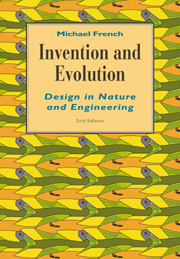Book contents
- Frontmatter
- Contents
- Preface to the second edition
- Preface to the first edition
- Acknowledgements
- 1 The designed world
- 2 Energy
- 3 Materials
- 4 Mechanism
- 5 Structures
- 6 Systems
- 7 The practice, principles and philosophy of design
- 8 Economy, form and beauty
- 9 Production, reproduction, evolution and design
- 10 Designing and inventing
- 11 Some case studies
- Questions
- Answers
- Suggestions for further reading
- Index
9 - Production, reproduction, evolution and design
Published online by Cambridge University Press: 06 January 2010
- Frontmatter
- Contents
- Preface to the second edition
- Preface to the first edition
- Acknowledgements
- 1 The designed world
- 2 Energy
- 3 Materials
- 4 Mechanism
- 5 Structures
- 6 Systems
- 7 The practice, principles and philosophy of design
- 8 Economy, form and beauty
- 9 Production, reproduction, evolution and design
- 10 Designing and inventing
- 11 Some case studies
- Questions
- Answers
- Suggestions for further reading
- Index
Summary
Production methods
In both nature and the works of man, methods of production exercise a powerful influence on design. Consider first two manufactured articles – a piece of furniture and a glass bottle. The first is made from pieces of wood, cut to shape in a large number of operations, fitted and glued together. If it is made by a craftsman working from drawings, the time taken will be very long, but he can easily make one piece of furniture a little wider, and the next a little taller. The production process is slow, but very flexible. Partial automation could be introduced, so that a leg, say, is put into a machine and the mortise for a tenon is cut as quickly as the words can be read, but then both the location of the mortise and its size will be fixed. Thus the manufacture can be made much faster, and it will be cheaper if enough pieces are made, but flexibility is lost.
The glass bottle is made in relatively few operations. A gobblet of hot, soft glass is roughly shaped and blown up to fill a mould, which dictates the outside shape, even to a manufacturer's name in relief. In fact, the outside shape of the bottle is a replica of the inside of the mould, for which reason this production method will be called ‘replicative’. The ultimate form of the piece of furniture, however, is nowhere to be seen in the tools which make it.
- Type
- Chapter
- Information
- Invention and EvolutionDesign in Nature and Engineering, pp. 253 - 282Publisher: Cambridge University PressPrint publication year: 1994



